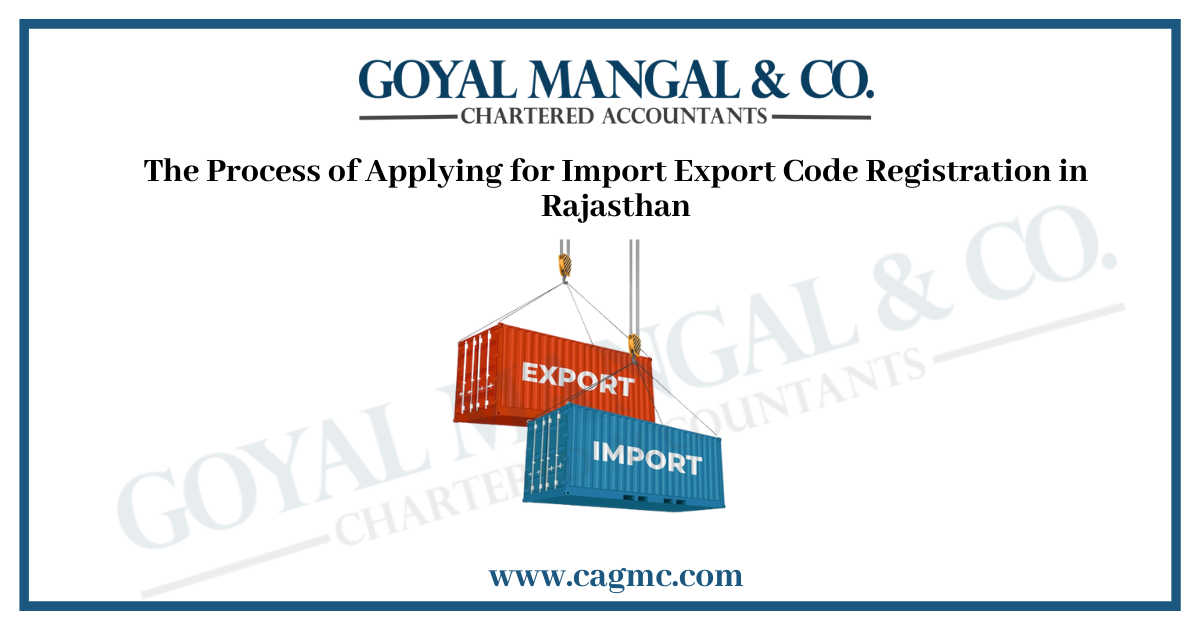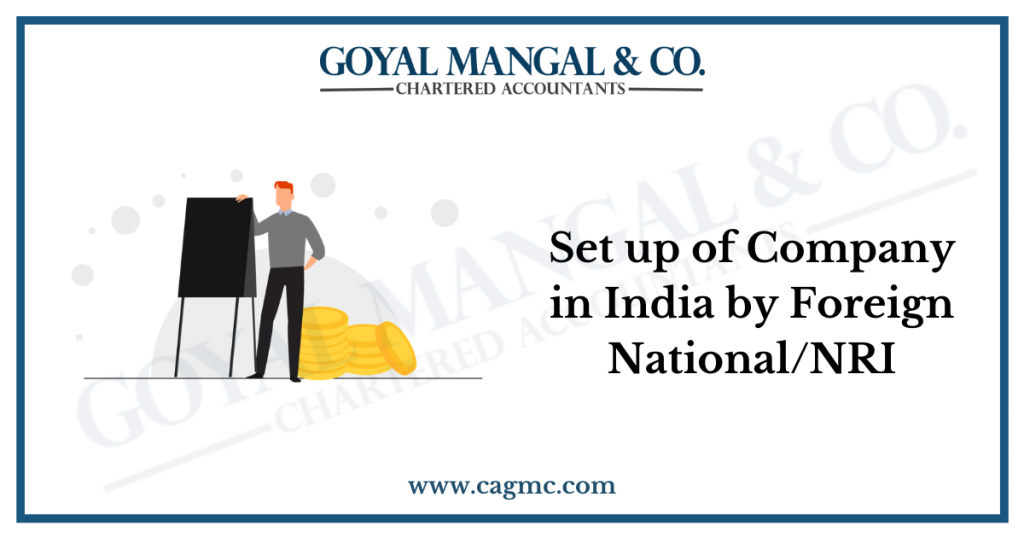 Welcome to the simplified guide on the Process of Applying for Import Export Code Registration in Rajasthan. If you’re a business enthusiast looking to venture into international trade, you’ll need to acquire an Import Export Code Registration in Rajasthan. This essential document is issued by the Directorate General of Foreign Trade (DGFT) and serves as your passport to engage in cross-border trade activities. In this guide, we’ll walk you through the key steps involved in obtaining your IEC registration in the state of Rajasthan, streamlining the process for your convenience. Let’s dive into the world of international trade by explaining the Import Export Code Registration in Rajasthan.
Welcome to the simplified guide on the Process of Applying for Import Export Code Registration in Rajasthan. If you’re a business enthusiast looking to venture into international trade, you’ll need to acquire an Import Export Code Registration in Rajasthan. This essential document is issued by the Directorate General of Foreign Trade (DGFT) and serves as your passport to engage in cross-border trade activities. In this guide, we’ll walk you through the key steps involved in obtaining your IEC registration in the state of Rajasthan, streamlining the process for your convenience. Let’s dive into the world of international trade by explaining the Import Export Code Registration in Rajasthan.
| Table of Contents |
Overview of Import Export Code (IEC) Registration
The Process of Applying for Import Export Code Registration is a mandatory requirement for individuals and businesses engaging in international trade activities. It is a unique 10-digit code issued by the Directorate General of Foreign Trade (DGFT), a government body in India, to facilitate and regulate cross-border trade operations. Obtaining your IE Code in Rajasthan opens doors to international markets, enhances trade opportunities, and boosts the economic landscape of the state. Whether you’re based in Jaipur, Jodhpur, Udaipur, or any other city in Rajasthan, securing your IE Code empowers you to navigate the intricacies of cross-border commerce effectively.
Key Points about IEC Registration
- Unique Identification: The IEC code is a distinct identification assigned to each entity. It helps customs authorities and regulatory bodies track and monitor trade activities, ensuring compliance with international laws and regulations.
- Legal Requirement: IEC registration is a legal obligation under the Foreign Trade (Development and Regulation) Act, 1992. It is necessary even if the business doesn’t deal with large volumes of goods, as it applies to any cross-border trade.
- Multiple Uses: Apart from facilitating imports and exports, the IEC code is also used for purposes such as customs clearance, claiming export incentives, and opening a foreign currency bank account.
- Online Application: The IEC registration process has been streamlined through online application systems. This allows applicants to submit their information, documents, and fees electronically, reducing paperwork and saving time.
- Validity and Renewal: Once obtained, the IEC code is generally valid for the entire tenure of the business. Renewals might be required if there are any changes in the business structure or details.
Eligibility Criteria and Documents Required
Eligibility Criteria for IEC Registration:
- Business Entities: Any individual, partnership firm, limited liability partnership (LLP), company, trust, or society engaged in export and import activities is eligible to apply for IEC registration.
- Permanent Account Number (PAN): All applicants must have a valid PAN issued by the Income Tax Department of India. PAN is a mandatory requirement for IEC registration.
- Legal Entity: The applicant must be a legal entity registered under the relevant laws in India. This ensures that the entity is recognized and authorized to conduct international trade.
- No Negative List: There are no specific restrictions on the type of business or sector. However, certain entities, such as individuals on the Directorate of Revenue Intelligence’s “Negative List,” are ineligible.
Documents Required for IEC Registration:
- PAN Card: Copy of the Permanent Account Number (PAN) card of the applicant entity.
- Identity Proof: Identity proof of the individual applicant or authorized signatory, such as Aadhaar card, passport, voter ID, or driver’s license.
- Address Proof: Address proof of the business entity or individual, which can include utility bills, bank statements, rent agreement, or property documents.
- Bank Details: A canceled cheque or bank certificate with the applicant’s name, account number, and IFSC code.
- Business Entity Proof: Depending on the type of entity, the following documents are required:
- For a company: Certificate of Incorporation and Memorandum & Articles of Association.
- For a partnership firm: Partnership Deed.
- For an LLP: Certificate of Incorporation and LLP Agreement.
- For a proprietorship: Sole Proprietorship Declaration or Registration Certificate.
- Digital Photograph: A recent passport-sized photograph of the applicant or authorized signatory.
- Authorized Signatory Proof: If the application is made by an authorized signatory, a copy of the board resolution or authorization letter designating the signatory.
- IEC Application Form: Duly filled and signed IEC application form, which is available on the DGFT website.
- Exporter-Importer Code (IEC) Format: A detailed format of how you will use the IEC, including the categories of goods/services you intend to trade.
- Self-Attested Copies: All the above documents should be self-attested by the applicant.
Online and Offline registration Process
Online Registration Process for IEC:
- Visit DGFT Website:
-
-
- Go to the official Directorate General of Foreign Trade (DGFT) website.
-
- Create an Account:
-
-
- If you don’t have one, register on the DGFT portal.
- Provide necessary details and create a username and password.
-
- Access IEC Application:
-
-
- Log in to your account and access the IEC application form.
-
- Complete Application Form:
-
-
- Fill in accurate details about your business, PAN, address, and authorized signatory.
-
- Upload Documents:
-
-
- Scan and upload required documents, like identity and address proofs, PAN card, and bank details.
-
- Review and Submit:
-
-
- Double-check all information and documents.
- Submit the application form electronically.
-
- Pay Application Fee:
-
-
- Make the IEC registration fee payment using available online methods.
-
- Receive Acknowledgment:
-
-
- An acknowledgment receipt with a unique reference number will be generated.
-
- Application Processing:
-
-
- DGFT reviews your application and documents.
-
- Approval and Issuance:
- Once approved, you’ll receive an email notification.
- Download your IEC certificate from the DGFT portal.
Offline Registration Process for IEC:
- Obtain Application Form:
-
-
- Visit a nearby DGFT regional office or download the IEC application form from the DGFT website.
-
- Fill Application Form:
-
-
- Complete the form accurately with personal and business details.
-
- Gather Documents:
-
-
- Collect necessary documents such as identity proof, address proof, PAN card, and bank details.
-
- Assemble Application Package:
-
-
- Attach photocopies of documents to the filled application form.
-
- Submit Application:
-
-
- Visit the DGFT regional office in person.
- Submit the application package along with the required fee.
-
- Receive Acknowledgment:
-
-
- Get an acknowledgment receipt containing a unique application reference number.
-
- Application Processing:
-
-
- DGFT reviews your application and verifies documents.
-
- Approval and Collection:
-
- Once approved, you’ll be informed to collect your IEC certificate from the regional office.
Application Processing and Timeline
Here’s a breakdown of the application processing and approximate timeline:
- Application Verification (1-2 Weeks):
- DGFT begins by verifying the accuracy and completeness of your application.
- Documents submitted are reviewed for compliance with requirements.
- Document Scrutiny (2-3 Weeks):
- Your submitted documents undergo thorough scrutiny.
- Cross-checking of details ensures adherence to guidelines and legal criteria.
- Clarifications (if needed) (Varies):
- In case of discrepancies or missing information, DGFT may request clarifications.
- Promptly respond with the requested details to avoid delays.
- Application Approval (3-4 Weeks):
- Once documents are verified and in order, DGFT proceeds to approve your IEC application.
- The official approval is conveyed through an email notification.
- IE Code Issuance (1-2 Weeks):
- Following approval, the DGFT generates your IE Code (Import Export Code).
- The IE Code certificate is made available for download on the DGFT portal.
- IE Code Activation (Immediate):
- Your IE Code is now activated, enabling you to engage in international trade activities.
Receiving IEC Certificate
After successful approval of your IEC application, the Directorate General of Foreign Trade (DGFT) will issue your Import Export Code (IEC) certificate. You’ll receive an email notification with instructions to access the DGFT portal. Log in, locate your approved application, and download your IEC certificate. This digital document confirms your eligibility for international trade operations. Store it securely and present it when engaging in cross-border transactions. The IEC certificate, a vital asset, showcases your authorization for imports and exports, contributing to seamless global business endeavors.
Conclusion
So, applying for Import Export Code Registration in Rajasthan is an essential step for businesses venturing into international trade. The IEC serves as a gateway to global markets, enabling smooth import and export operations. By complying with the Directorate General of Foreign Trade (DGFT) guidelines, businesses in Rajasthan can harness the benefits of cross-border commerce, expand their reach, and contribute to the state’s economic growth. With the IEC certificate in hand, entrepreneurs can confidently explore new horizons, establish international partnerships, and thrive in the dynamic world of international trade.


